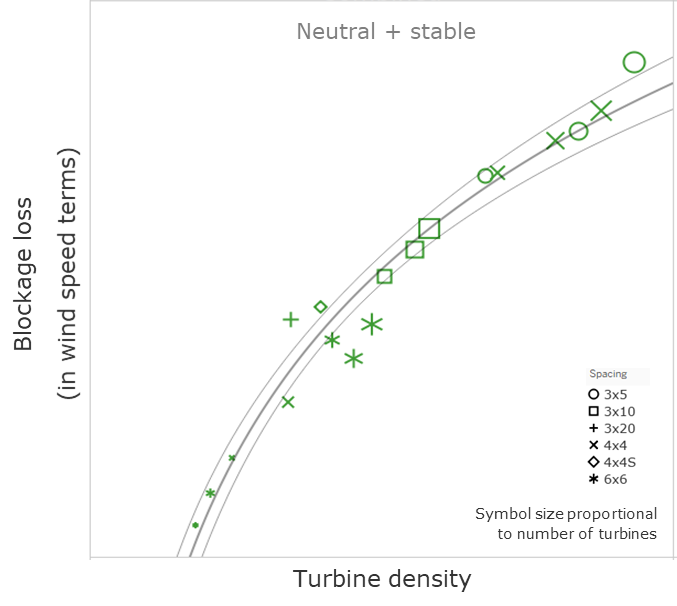Wind farm blockage
This wind-farm-scale blockage effect impacts all wind farm projects, both onshore and offshore. The magnitude of the effect will depend on several factors, including the turbine characteristics, the turbine layout/locations, and site-specific atmospheric conditions. It is the combination of these parameters rather than the onshore/offshore distinction that determines the magnitude of the effect. According to DNV’s state of knowledge in January 2020 and depending on project-specific factors, previously unaccounted for turbine interaction losses related to blockage represent 0% to 4% of mean annual energy yield.

WindFarmer: Analyst includes DNV’s Blockage Effect Estimation Tool (BEET) for estimating the wind farm blockage effect. The BEET calculates an overall efficiency to correct the long-held wake modelling assumptions that a turbine in the front (upstream) row of turbines will produce the same energy as a single turbine operating in isolation.
The BEET model was trained using results from 100s of full wind farm CFD turbine interaction simulations. The wind farm CFD model was developed and validated after several years of research by DNV, as described in the paper published in the scientific journal Energies in June 2018 [31].
To construct the BEET model, we calculated blockage correction factors using CFD at a number of generic wind farms operating on flat terrain. Then we fit curves to the results, finding a strong sensitivity to the density of the turbine layout, as well as to atmospheric stability and to the ratio of hub height to rotor diameter.


The BEET has been shown to agree well mostly with CFD predictions at other farms outside of the training set as shown in these additional resources:
| Resource | title | Description |
|---|---|---|
| Webinar & FAQs | Blockage effects in WindFarmer: Analyst | Link includes access to slides and FAQs |
| Webinar | Explaining the blockage effect on wind farm yield | What non-technical people need to know |
| Paper | Wind Farm Blockage and the Consequences of Neglecting Its Impact on Energy Production | Published in the scientific journal Energies in June 2018 |
Blockage model settings in WindFarmer: Analyst
The blockage calculation can be configured in the Energy Calculation Settings task.
Stability classification
The Blockage loss is greater for wind farms with significant stability. You should choose the classification which best represents your site.

Including nearby wind farms in the blockage calculation
On most projects you should use the default setting including all non-neighbour wind farms in the blockage calculation.
There is no explicit minimum distance for including neighbouring wind farms within the blockage calculation, but to consider including a neighbouring farm it should be quite close – the neighbouring projects basically need to be extensions of the subject wind farm (i.e. within about 1,000 m of the nearest turbine in your wind farms, in a location where you would expect them to modify the wind speeds in the front row in the prevailing wind direction).

Blockage modelling process
Internal to the calculation, each run of the BEET calculation uses the following inputs. These inputs are derived in WindFarmer: Analyst automatically based on your workbook setup:
| Input | Description |
|---|---|
| Power curve | Taken from a turbine type and adjusted to the hub height air density averaged over all the included non-neighbour turbines included in the calculation. |
| Thrust curve | Taken from a turbine type included in the calculation |
| Wind speed frequency distribution | Taken from a wind climate that initiates turbines included in the calculation and scaled to the un-waked hub-height wind speed averaged over all the non-neighbour turbines included in the calculation. |
| Layout | All turbines in the included wind farms define turbine locations input into the BEET. |
Layouts with a mix of turbine types and initiation masts
For layouts with a mix of turbine types and initiating frequency distributions the BEET is run multiple times with one FD and turbine type per run for every turbine type-FD pair found within the set of input turbines. The results are combined using a weighted average, weighting by the full yield produced by the turbines with the turbine type-FD combination for the run. This pragmatic approach to calculating the blockage effect is used because the BEET was trained on homogenous turbine type wind farms with one turbine type and one representative frequency distribution.
To reduce the uncertainty in a blockage estimation, for unusual wind farm layouts or farms with a significant mix of turbine sizes DNV can perform Blockage CFD modelling. http://www.dnv.com/wind-cfd
Details of inputs to each run can be exported by outputting the intermediate blockage results.

Please note…
The blockage efficiency is NOT included in the Full yield. The full yield is the yield including wakes, hysteresis and sector management output but no other losses output from the energy calculation. This is because blockage calculated via the BEET is at a wind farm level whereas Full Yield is calculated on a per turbine basis. DNV are actively researching ways to simulate blockage on a per turbine and direction basis and intend to include this more advanced model in a future version of WindFarmer.
Blockage is incorporated in the Net Yield after running the Monte Carlo Net Energy simulation. After exporting a report (or TSV results) you can find the blockage efficiency in the efficiencies table alongside the other losses.
Optimising with blockage: if “Apply wind farm blockage model” is checked the blockage efficiency is multiplied by the Full yield and used as the optimisation target. Please use this with caution: the BEET provides overall blockage efficiencies, not turbine specific values.